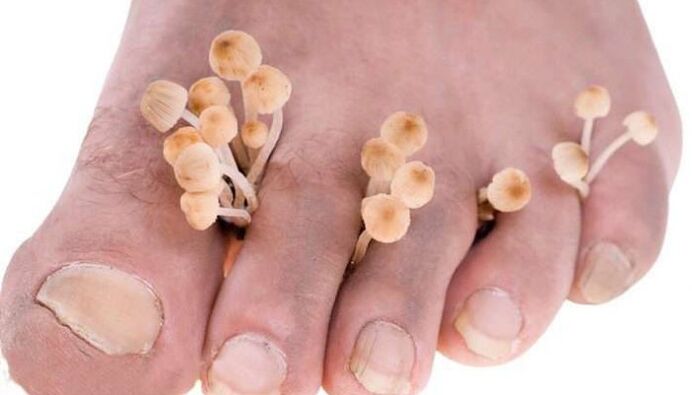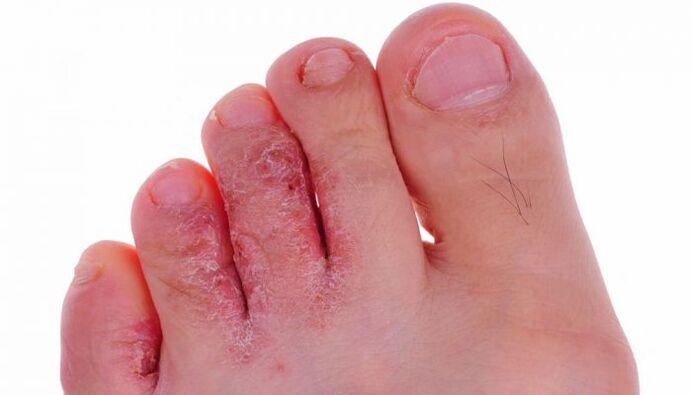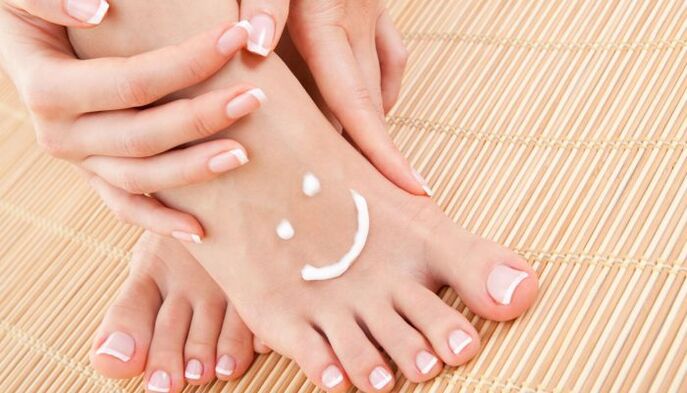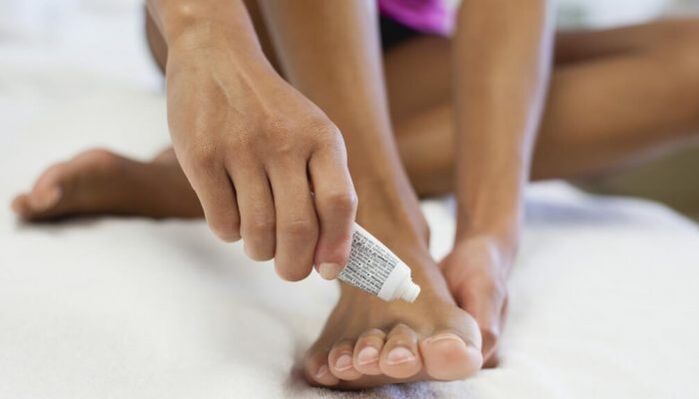The skin between the toes is often susceptible to fungal infection. This problem is common among people who lead an active lifestyle and is quite burdensome and uncomfortable. Considering the great importance of foot mycoses, they should be given more attention.
Causes of itching and peeling in the interdigital folds

Toes itch and peel due to various pathological processes - allergic reactions, scabies, eczema - but in many people such symptoms are caused by a fungal infection. The epithelium becomes moist and bursts with foot mycosis, which is a special nosology in dermatology. It is caused by pathogenic fungi that affect smooth skin and nail plates. The infection is caused by several pathogens:
- Trichophyton (T. rubrum, T. interdigitale, T. violaceum).
- Epidermophyton (E. floccosum).
- Mold fungi.
Mycosis is an infectious disease that is transmitted from one person to another in places with high humidity (bathrooms, saunas, swimming pools, beaches) through infected shoes, mats, benches, etc. Fungal spores are found in large quantities in the horny scales of the epidermis, with which they are transmitted.
Predisposing factors
A number of local and general factors contribute to skin lesions, increasing the likelihood of developing a fungal infection between the toes. The former include the following:
- Excessive sweating (hyperhidrosis).
- Improperly selected shoes (uncomfortable, made of synthetic materials).
- Anatomical characteristics of the feet (flat feet, firm folds).
- Presence of scratches and diaper rash.
- Injuries (mechanical, chemical).
The role of systemic disorders is explained by a decrease in the resistance of the skin barrier and a weakening of the immune defense. Neurotrophic, vascular and endocrine metabolic diseases (polyneuropathy, angiopathy, atherosclerosis, diabetes mellitus, hypovitaminosis) have a negative impact. In addition, the role of meteorological conditions (high temperature and humidity) and pathogen virulence was also observed.
Mycosis of the feet with skin lesions between the toes is caused by fungi and develops against the background of local or systemic disorders.
What does mycosis look like?

Mycosis begins on the skin of the interdigital folds, but then spreads to other parts of the foot - the sole, back and lateral surfaces. In clinical practice, there are several forms of fungal infection:
- Squamous.
- Intertriginous.
- Dyshidrotic.
The squamous form begins with mild redness and mild peeling. They may be confined to certain areas or become widespread. This form often goes unnoticed by the patient, so it is the most dangerous in an epidemiological sense. At first, the fungus affects one foot, but later it can spread to the healthy side.
As it progresses, the squamous form can pass into the dyshidrotic form, which is characterized by an acute course with body allergy and the formation of blisters on the arch of the foot. Joining, they form multichamber blisters, which after opening leave eroded foci surrounded by the edge of the peeled epidermis. Spreading to the lateral surfaces of the feet, the process is combined with the intertriginous form. As epithelialization occurs, the areas dry out, becoming squamous again.
Foci of fungal infection are often accompanied by itching. It comes from interdigital folds in the most common form - intertriginous, which occurs independently or on the background of squamous ones. Usually the process starts between IV and V (less often III and IV) fingers. Cracks appear there, surrounded by the edge of the peeled epidermis. The fungus can spread to other folds, toes and the back of the foot. Later, crying with painful erosions occurs.
The disease is characterized by a long course with periodic exacerbations that occur in the warm season. Bacterial flora penetrate more easily through the relaxed stratum corneum of the epidermis, so the intertriginous form can be complicated by streptococcal infection with the development of erysipelas and thrombophlebitis.
Damage to the interdigital spaces often occurs in combination with other forms of foot mycosis, which indicates the unity of pathological processes.
Diagnostics
The disease has a rather characteristic clinical picture, so the initial diagnosis is carried out based on the results of a medical examination. To identify the pathogen, microscopy and culture of scrapings from the affected skin are used. The presence of systemic pathology that contributes to the development of mycosis is confirmed by additional methods - a biochemical blood test (glucose, hormonal spectrum, immunogram), ultrasound examination of the lower extremities, etc.
How to treat a wound?

To effectively get rid of fungus, you must first eliminate the conditions that create favorable conditions for its development. If your foot itches and hurts, we recommend that you pay attention to the following recommendations:
- Wear comfortable, breathable shoes.
- Wear cotton socks.
- After showering and bathing, dry your feet.
- Use personal slippers in public places.
When treating mycosis of the feet, attention is paid to giving up bad habits, healthy diet (reduction of animal fats, sweets, including fresh vegetables, fruits, lactic acid products in the diet), tempering.
In addition to general recommendations that have a therapeutic and prophylactic focus, traditional medicine actively uses means to correct drugs, without which it is not possible to cure mycosis. Therapy can be external or systemic.
Effective creams and ointments
It is necessary to fight the infection with specific drugs that work against the fungus on the toes. For the squamous form, the doctor prescribes various creams and ointments, which include various antimycotics. If there are dense foci of hyperkeratosis on the soles, treatment begins with peeling with salicylic acid, lactic acid, resorcinol and collodion. At night, a medicine intended for external use is placed under the bandage. It contains salicylic acid, which has anti-inflammatory, keratolytic and antiseptic properties, and in the morning you bathe with soap and soda, after which the inflamed masses will be better removed.
If your skin gets wet and cracks

External treatment of the dyshidrotic form with weeping and cracks begins with lotions with boric acid and potassium permanganate. Interdigital spaces are treated with solutions of aniline dyes, a preparation for external use intended for the treatment of various skin diseases. The solution contains components that promote rapid healing of wounds, remove inflammatory manifestations and fight against pathogenic microorganisms. After eliminating the acute inflammatory process, antifungal ointments and pastes are applied to the affected areas. For secondary pyoderma, drugs with antibacterial components are prescribed.
With mycotic lesions of the skin of the feet, external therapy with antifungal agents, antiseptics and antibiotics is of crucial importance.
Pills
If local agents are ineffective, it is necessary to switch to drugs for internal use. Antifungal drugs that are prescribed include antifungal drug, antifungal drug that has a broad spectrum of action against fungi that cause skin, hair, and nail diseases, drug to treat fungal infections, antifungal drug. Antihistamines (antihistamine medication intended for the treatment of allergic reactions) and desensitizing agents (calcium gluconate, sodium thiosulfate, magnesium sulfate) are used when the body is allergic. Streptococcal infections can be cured with antibiotics that do not have an activating effect on the microbial flora.
What can be done from folk remedies?
Some methods of traditional medicine can be an addition to standard therapy. For the treatment of foot fungus, baths using simple and affordable drugs are often used:
- Apple cider vinegar (1 glass per 3 liters of hot water) and soda (5 spoons).
- Potassium permanganate (1 g per 2 l).
- Decoction of calendula flowers (250 g per 2 l).
It is recommended to soak the feet in the prepared solution for 20 minutes. Additionally, you can apply a drop of tea tree essential oil to the skin between your toes and then put on cotton socks.
Fungus between the toes is a problem that affects many people. In order to get rid of it as soon as possible, you should not look for possible solutions yourself, it is better to consult a doctor, undergo diagnostics and treatment with a guaranteed result.
















